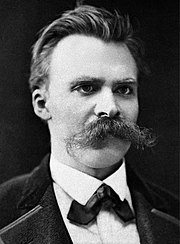Friedrich Nietzsche's Human Design Chart
2/4 Emotional Manifesting GeneratorGerman philosopher, cultural critic, composer, poet, philologist, and Latin and Greek scholar who is considered the most influential voice since Kant and Hegel. He taught classes until 1879, then spent the next ten years in solitude. These years were spent writing his major works “Thus Spoke Zarathustra” and “Twilight of the Idols.”
Nietzsche came from a long line of Lutheran pastors and was destined to follow in the footsteps of his clergyman dad, who died after 11 months of suffering from a serious illness, when the boy was age five. Shortly after his father’s death, his younger brother died, leaving him to live with his mother, younger sister, grandmother and two aunts. He received a strict Christian upbringing as his mother was also the child of a Protestant minister. He suffered continually from severe headaches, sore throats, and rheumatic ailments as a kid, especially during his school days. At age 23, recognized for his brilliant work, he was appointed to the chair of philology at the University of Basel, 13 February 1868 and later was granted to Doctorate without examination, 23 March 1868. He eventually dropped his theological studies to take up classical philology, and later philosophy.
His dealing with the opposite sex were consistently awkward. He made a precipitous and impulsive proposal to Mathilde Trampendach on 11 April 1876, two hours after meeting her. The winter of 1882 and summer 1883 were probably among the loneliest and most desperate period in his life, the time when he began his “Thus Spoke Zarathustra.”
In 1879, at the age of 35, Nietzsche resigned his post a professor of classical philology at Basel University and began a decade of travels across Europe, during which he wrote his greatest books. He had a desire to define himself as a European and looked forward to a time when the peoples of Europe would define themselves as Europeans rather than as citizens of particular countries. It might have been a way for him to distance himself from the militaristic, bureaucratic, bourgeois Germany of Bismarck, whom he abhorred. He believed that history is a genealogy of geniuses, in which each genius created the mental world in which his successors live.
His mental degeneration, at the time assumed to be caused by syphilis, began with megalomania. Nietzsche started to call himself a genius, the leading person of all millenniums and he claimed that all women loved him. He took on different identities – the Buddha, Alexander the Great, Caesar, Voltaire, Napoleon, Wagner – and danced naked in his room. In January 1889 he broke down in the street and tearfully embraced a horse which had been beaten. He was declared insane by doctors and taken back to Germany where he sat in a vegetative state until his death eleven years later, on 25 August 1900, Weimar, Germany.
The diagnosis of syphilis has since been challenged and a diagnosis of “manic-depressive illness with periodic psychosis followed by vascular dementia” was put forward by Cybulska prior to Schain’s study. Leonard Sax suggested the slow growth of a right-sided retro-orbital meningioma as an explanation of Nietzsche’s dementia; Orth and Trimble postulated frontotemporal dementia while other researchers have proposed a hereditary stroke disorder called CADASIL. Poisoning by mercury, a treatment for syphilis at the time of Nietzsche’s death, has also been suggested.
Link to Wikipedia biography
Discover More Famous People
Browse and analyze over 55,000 public figures and celebrities.
Ra Uru Hu
5/1 Manifestor
Martha Stewart
4/6 Manifestor
David Lynch
4/6 Generator
Barack Obama
6/2 Projector
Steve Jobs
6/3 Generator
Vladimir Putin
5/1 Manifestor
Kim Kardashian
3/5 Generator
Michael Jackson
1/3 Projector
Marilyn Monroe
6/2 Projector
Ariana Grande
2/4 Projector
Oprah Winfrey
2/4 Generator
Johnny Depp
2/4 ManifestorWhat is HumanDesign.ai and how does it work?
Curious what makes Friedrich Nietzsche tick? HumanDesign.ai instantly maps their exact birth data into a fully interactive clickable bodygraph chart, letting you hover or tap every center, channel, and gate for plain-language explanations. Bella, the platform’s built-in AI guide, adds context in real time, translating complex mechanics into everyday insights so you can see how Friedrich Nietzsche’s strengths, challenges, and life themes play out on-screen.
The same tools are waiting for you. Generate your own Human Design Chart in seconds, open a library of 2000+ suggested questions, and chat with Bella as often as you like to decode your design, daily transits, and even relationship dynamics.
Want to compare energies? Save unlimited charts for friends, family, or clients, then ask Bella to reveal compatibilities, composite patterns, or coaching tips, all in one conversation thread.
Start free with core features, or unlock our Personal and Pro plans for deeper dives: unlimited Q&A, celebrity chart search spanning 55,000+ public figures, white-label PDF reports, branded content generation, and a professional profile with built-in booking for practitioners. Whether you’re exploring your own potential or guiding others, HumanDesign.ai delivers an ever-expanding toolbox of AI-powered insights—no spreadsheets, no jargon, just clarity at your fingertips.
Ready to see yours? Signup for FREE today!

